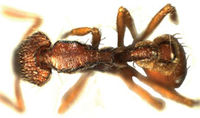Strumigenys nankunshana
| Strumigenys nankunshana | |
|---|---|

| |
| Scientific classification | |
| Kingdom: | Animalia |
| Phylum: | Arthropoda |
| Class: | Insecta |
| Order: | Hymenoptera |
| Family: | Formicidae |
| Subfamily: | Myrmicinae |
| Tribe: | Attini |
| Genus: | Strumigenys |
| Species: | S. nankunshana |
| Binomial name | |
| Strumigenys nankunshana (Zhou, 2011) | |
The type colony was found nesting under a stone.
Identification
Tang and Guénard (2023) - A member of the Strumigenys leptothrix-group that is provisionally assigned to the elegantula complex.
Zhou (2011) - Strumigenys nankunshana resembles Strumigenys elegantula but differs from the later by its cephalic dorsum with 3 pairs of long simple standing hairs in profile view, dorsum of pronotum with distinct transverse striations and without a median long stria, and disc of petiole with transverse rugae. It differs from P. leptothrix Wheeler by its leading edge of scape without anteriorly projecting straight suberect simple hair, standing hairs on cephalic dorsum much less, dorsal surface of body without standing hairs.
Keys including this Species
Distribution
Nankunshan National Forest Park, Guangdong Province, China.
Distribution based on Regional Taxon Lists
Palaearctic Region: China (type locality).
Distribution based on AntMaps
Distribution based on AntWeb specimens
Check data from AntWeb
Countries Occupied
| Number of countries occupied by this species based on AntWiki Regional Taxon Lists. In general, fewer countries occupied indicates a narrower range, while more countries indicates a more widespread species. |

|
Estimated Abundance
| Relative abundance based on number of AntMaps records per species (this species within the purple bar). Fewer records (to the left) indicates a less abundant/encountered species while more records (to the right) indicates more abundant/encountered species. |

|
Biology
Castes
Known only from the worker caste.
Nomenclature
The following information is derived from Barry Bolton's Online Catalogue of the Ants of the World.
- nankunshana. Pyramica nankunshana Zhou, 2011: 420, figs. 1-3 (w.) CHINA. Combination in Strumigenys: unpublished.
Unless otherwise noted the text for the remainder of this section is reported from the publication that includes the original description.
Description
Worker
Holotype. TL 2.8, HL 0.70, HW 0.50, CI 71, ML 0.10, MI 14, SL 0.33, SI 66, PW 0.25, AL 0.70. Head with mandibles subtriangular, narrower in front than behind, occipital margin deeply concave, occipital corners bluntly rounded. Mandibles with a row of small teeth. Clypeus as broad as long, anterior border roundly convex. Antennae 3rd to 6th segments in a ratio of 2.5 : 2.0 : 4.0 : 12.0; 3rd segment 1.1× as long as broad; 4th segments as long as broad; 5th segment 1.5× as long as broad; apical segment 3 × as long as broad.
Pronotum marginate dorsolaterally, its dorsum flat, lateral borders subparallel in dorsal view. Propodeal spines subtended by broad lamellae, strongly developed, narrowly triangular, tip upturned. Petiolar disc 1.8× as long as broad, postpetiolar disc 1.4× as broad as long dorsally.
Head with numerous, curved, slender, spatulate hairs. In profile view, cephalic dorsum with 3 pairs of standing hairs: 1st pair of hairs close to occipital margin; 2nd pair are in front of, and out of the 1st pair; and the 3rd pair on the upper margin of antennal scrobe just behind the eyes. In full face view, lateral clypeal dorsum with decumbent hairs. Anterior margin of antennal scapes with arranged, slender, spatulate hairs which are curved anteriorly. Dorso-lateral borders of alitrunk with 4 pairs of long erect hairs, humeral hair straight and simple, projecting laterally; masonotum with 3 pairs of standing simple hairs. Dorsal surfaces of middle and hind tibiae with suberect long straight simple projecting hairs, the longest of them distinctly longer than the maximum tibial width. First gastral tergite with more than 30 long erect hairs, restricted to 5-6 transverse rows.
Dorsal surface of head reticulate and rugose. Antennal scapes microreticulate. Dorsum of alitrunk finely microreticulate, with distinct transverse striations, without longitudinal median stria. Lateral surface of pronotum smooth and shining, mesonotum and propodeum microreticulate. Lateral surface of petiole microreticulate, disc finely reticulate and rugose transversely. Postpetiolar disc and gaster smooth and shining.
Color reddish brown; clypeus, mandibles, antennae, and legs yellowish brown.
Paratype workers. TL 2.7-2.8, HL 0.70-0.72, HW 0.49-0.50, CI 69-71, ML 0.10-0.11, MI 14-15, SL 0.33-0.34, SI 66-68, PW 0.25-0.27, AL 0.68-0.70 (5 individuals measured).
Type Material
Holotype worker. Nankunshan National Forest Park, Guangdong Province, South of China, August 22, 2010, Shanyi Zhou leg. Paratype 20 workers.
Etymology
The species is named after its type-locality, Nankunshan.
References
- Tang, K. L., Guénard, B. 2023. Further additions to the knowledge of Strumigenys (Formicidae: Myrmicinae) within South East Asia, with the descriptions of 20 new species. European Journal of Taxonomy 907, 1–144 (doi:10.5852/ejt.2023.907.2327).
- Zhou, S. 2011. A new species of the ant genus Pyramica from Nankunshan National Forest Park of Guangdong, South of China. Sociobiology. 57:419-424.
References based on Global Ant Biodiversity Informatics
- Guénard B., and R. R. Dunn. 2012. A checklist of the ants of China. Zootaxa 3558: 1-77.
- Zhou S. 2011. A new species of the genus Pyramica (Hymenoptera: Formicidae) from Nankunshan National Forest Park of Guangdong, South of China. Sociobiology 57: 419-424.

